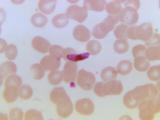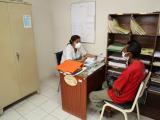Nov 16, 2010
Reports call for global sanitation and water improvements to combat disease
Global improvement in hygiene, sanitation, and water could save 2.4 million lives annually, most of them children, according to the lead article in a series of four recent reports that call on health professionals to get involved in addressing these three areas. The four policy articles were published last week by PLoS Medicine. In the introductory article, two public health experts write that diarrheal diseases kill more young children each year than HIV/AIDS, tuberculosis, and malaria combined. They report that only 61% of the world's population has some form of improved sanitation—a hygienic latrine or flush toilet—at home, and only 54% of the population receives piped water at home. The second article focuses on water supply issues, while the third addresses the importance of improving sanitation. The last article outlines what needs to be done to make significant progress on all three fronts.
PLoS Medicine series introduction with links to reports
Cargill cites positive preliminary results in test of E coli cattle vaccine
The agribusiness company Cargill has reported encouraging preliminary results in a trial of an Escherichia coli O157:H7 vaccine in 85,000 beef cattle in the company's feedlots in Fort Morgan, Colo. At a conference in Minneapolis yesterday, Dan Schaefer, Cargill's assistant vice president for beef research and development, said the company was pleased with the preliminary findings but awaits analysis of the findings by several independent researchers, according to a Cargill press release. "Because we saw a favorable immune response to the vaccine that we were hoping for, and the cattle had no adverse reaction, we believe there is enough evidence to move forward with a second vaccine trial, and anticipate doing so in summer 2011," Schaefer said. The preliminary results came from sampling both cattle in feedlots and meat from the company's Fort Morgan processing facility. The company noted that a low level of E coli O157:H7 was found in unvaccinated control cattle at the facility, which could influence the significance of the results for the vaccinated animals. The vaccine is made by Epitopix LLC, based in Willmar, Minn.
Nov 15 Cargill press release
Intranasal rotavirus vaccine shows promise
A trial of an intranasal rotavirus vaccine in mice produced an protective immune response, and the new vaccine platform might someday be used as an inexpensive way to immunize humans against other diseases such as tetanus and pertussis, according to a Tufts University press release. The study appeared in the Nov 1 issue of Clinical and Vaccine Immunology. The vaccine, which is administered as nasal drops or spray, uses the harmless Bacillus subtilis bacterium, which researchers can modify to include proteins from rotavirus or other infectious agents. They said vaccines made through this method can be produced inexpensively in large quantities and, based on their experience with a tetanus vaccine prototype, can be stored without refrigeration, making them easier to distribute in developing countries. Research team leader Dr Abraham Sonenshein said in the press release that the vaccine platform is still in the development stage and that the next step is to assess safety and efficacy in humans.
Nov 16 Tufts University press release
Nov 1 Clin Vaccine Immunol abstract


















